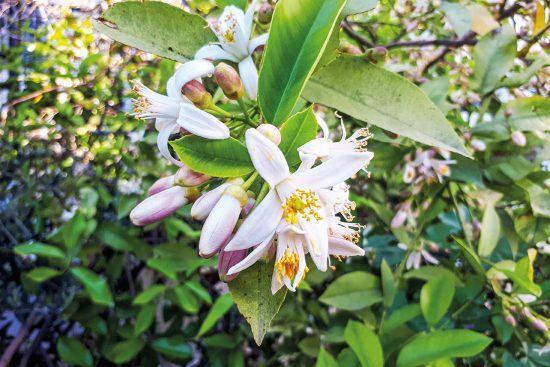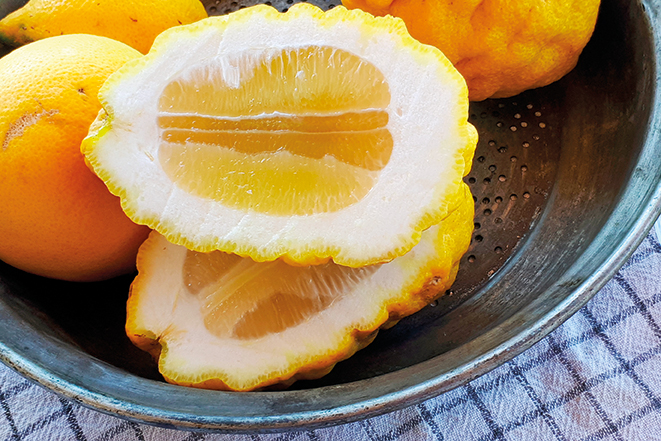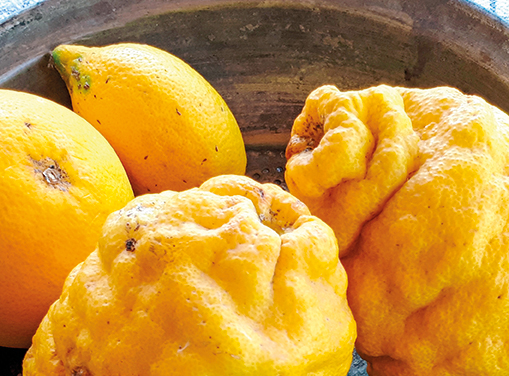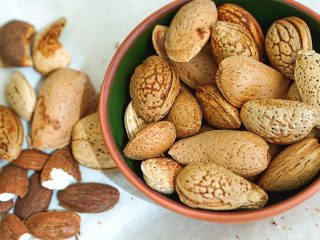While many people’s only experience with bergamot is sipping a cup of Earl Grey, the bergamot oranges grown in Bodrum are used for a variety of culinary applications, from the well-known flavored tea to jams and desserts.
By Chris Drum Berkaya
Winter brings fresh discoveries on Turkey’s Bodrum Peninsula, and one of the most intriguing is the big, lumpy, yellow citrus fruit sometimes found at market stalls. It looks like an overgrown lemon but is far too creased and wrinkled to be a smooth-skinned grapefruit. Locals call this fruit the bergamut, or bergamot orange, which has a short season and is rarely found later than January.
Mature bergamot trees in the sheltered gardens of Bodrum flower in April with big, bold, white flowers tinged with purple, bearing a lovely scent. Unlike the neighboring lemon or mandarin trees bearing the last of the winter fruits while new flowers begin to bud, bergamot oranges are picked early, as the branches can break under the weight of the heavy fruits. In the homes of these same old gardens the Bodrum matrons gather over their afternoon tea and share the recipe for making the bergamot jam. There are techniques particular to the fruit as it has a quite bitter flesh and a very thick pith while the outer yellow rind is thin but very aromatic and oily.
Sharing traditions
Bodrum-based Ayşe Akbaş remembers the bergamot oranges in her grandparents’ orchard in Gümbet and she lights up with pleasure while demonstrating how to prepare the fruit for jam. Taking a small paring knife, she peels the thin, yellow rind off the fruit, digging into the wrinkled skin to remove it all. She then cuts deep into the fruit to reveal the white pith, which is over one centimeter deep, to Akbaş’s approval. Unlike other citrus such as mandarins, oranges, and grapefruit, the white pith of the bergamot is the prize, and the flesh can be discarded or juiced for salads. The dried, finely cut rind is added to tea for flavor.
When making jam, Akbaş sometimes grates the pith, but often cuts it into cubes instead to give texture and color to the final product. The pith must be thoroughly boiled, once to remove the bitterness, then squeezed to press the water out before being boiled again in fresh water with sugar. Bergamot is pectin rich and, therefore, makes a thick jam. Akbaş also uses the cubed pith in syrup as a sweet topping over pastry.

Bergamot’s long-traveled road
The word bergamot comes from the Italian bergamotta, which gets its name from the Italian town of Bergamo, but it also has a folk etymology that it comes from the Turkish beg-armudi, or “prince of pears”. Its flavor is known worldwide, as the rind and essential oil are used in Earl Grey tea, and for perfumes. These come from Italy’s bergamot industry on the southern shores of Calabria. The rough-skinned, fist-sized fruits of Bodrum with the characteristic thick, white pith are a hybrid between bitter orange (Citrus aurantium) and sweet lime (Citrus limetta), known as ağaç kavunu (tree melon) in the Antalya-Adana region, which, according to the website PlantLives, was the first of the four original citrus fruits to be brought to the Mediterranean from Persia around 400 BCE.
Some of the bergamot trees in Bodrum’s gardens and orchards may have come with the mandarin plantings and orchard programs in 1947–1950 when stocks of saplings were brought from the Dodecanese islands, but most likely were brought earlier by the great writer and plantsman, Cevat Şakir Kabaağaçlı, known by the pen name the Fisherman of Halicarnassus. In his autobiographical book Mavi Sürgün (The Blue Exile), he recalls that he brought 18 kinds of citrus to Bodrum, planted the seeds, and wrote a book about how to cultivate them. Cultivation and planting of young bergamot saplings continues in the frost-free citrus orchards around Gümüşluk and Kadıkalesi, and the prized, expensive jam is sold by entrepreneurial women at weekly markets in Yalıkavak, Ortakent, and Turgutreis. Bergamot jam is a very special product from Bodrum, and is included in the new labels of citrus and fruit jams now produced in Bodrum that grace many summer breakfast tables.

Where to find bergamot products
- Erman Aras, son of the original mandarine farmer, Ömer Aras, has launched the citrus jam line Bodrum Yadi Gari. To order visit www.bodrummandalini.com
- Founded in Gümüşlük, Lokmacı Ana jams and marmalades are sold at Migros, Kipa, and Macrocenter stores, as well as at independent shops. www.lokmaciana.com
- Cıngıloğlu jams are available at Cıngıloğlu gourmet shops in Bodrum, Konacik, Yalikavak, Turgutreis, and Milas. www.cingiloglu.com.tr
Bergamot dessert recipe
Kısmet restaurant chef and local foods researcher Halil Vural follows the techniques described in the article for his recipe for a bergamot dessert, which is included in his recipe book Kısmet te Ne Varsa.
Ingredients:
- 8-10 whole bergamot fruits (will yield about 500 grams of pith)
- 1 kilo sugar
- 1 liter water
- Juice of 1 lemon
Rinse the bergamot and peel off the yellow rind without cutting deeper into the pith and clean the creased and wrinkled sections a knife. Continue with a knife, carefully peeling the pith into sections like an orange, separating it from the flesh, and press excess water out of the pieces. The inner flesh can be discarded. Leave the sections of pith to soak in water for 2 days, changing the water twice a day in the morning and evening.
Put 3 liters of water in a pot, bring to the boil, add the pith pieces, and boil for 20 minutes. Strain out the pith and save one liter of the used water. Bring the water to a boil again with sugar stirred into the reserved one liter of water, add the pieces of pith, then simmer for one hour on low heat. Add the lemon juice and continue boiling for five minutes more before removing it from the heat. Place a lid over the pot immediately and keep closed while cooling.
Serve with double cream and walnuts.











